| Pipistrelle - small, similar size to a sparrow or a
swallow, 9ins/23cm wingspan, usually erratic in flight and difficult to mistake
for a bird, flies lower than top-of-tree height, often along hedges, woodland
edges/rides or lines of trees, in sheltered gardens, around ponds, lakes,
lodges. Typically it emerges about 10 minutes after sunset when it’s just
starting to go dark, but sometimes earlier or later. A bat detector is usually
not needed for identification until after dark. By far the most common species
in the South Lancashire area. Around 90% of all bats in Britain are
pipistrelles - and there are 14 other species in Britain besides the
pipistrelle. There are two species of pipistrelle, the 45 and 55 (they
echolocate at different frequencies, 45 and 55 KHz, and have only recently been
recognised as separate species), confirmed in the South Lancashire area, with a
possible third in the Nathusius pipistrelle. |
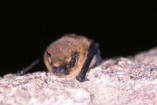 45KHz
Pipistrelle. © Hugh Clarke 45KHz
Pipistrelle. © Hugh Clarke |
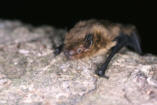 Soprano
Pipistrelle. © Hugh Clarke Soprano
Pipistrelle. © Hugh Clarke |
| Daubenton’s - slightly bigger than pipistrelle.
Typically feeds over still/sheltered ponds, lodges or rivers close to the
water’s surface and parallel with same, where it can be seen just as night
falls. Has shallow wing beats, which give a more “quivering”
impression than pipistrelle flight. (Away from water feeds in similar
situations to pipistrelle, gardens unlikely however, but often flies at fixed
height and can look to be “sailing” on an invisible sea. Hard to
distinguish in these settings without bat detector. Assume
“pipistrelle” if in any doubt at all.). Can be located over surface
of water when it flies through the beam of a powerful torch. |
 Daubenton’s Bat. © J Kaczanow Daubenton’s Bat. © J Kaczanow |
|
| Noctule
- easy to distinguish and all records of sightings are extremely valuable. Rare
in some areas, prevalent in others within South Lancashire. Large bat,
14ins/35cms wingspan, emerges before dark - overlapping slightly in time with
swifts, which are similar in size, before they retire to roost. Emerges,
usually from a tree hole, then flies fast in a straight line, over the top of
woodland and across open areas to its feeding grounds. These can be miles away.
Often feeds over lakes or reservoirs or alongside woodlands. The only local bat
that flies high in the open. Makes sudden dives to catch insects. Direction of
flight important to note, as this indicates not only where they might be flying
to, in order to feed, but also whereabouts they may have come from, i.e. the
location of the roost. |
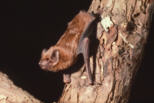 Noctule Bat.
© R Stebbings Noctule Bat.
© R Stebbings |
|
| Whiskered/Brandts - similar size as pipistrelle and emerges
at the same time. Prefers areas of semi-natural vegetation - streams through
woodlands where the vegetation is relatively dense for example. Follows same
flight line at fixed height, often involving circling in confined places, and
can give impression of running repeatedly round the same invisible railway
track. Use of a bat detector is helpful for identification. |
 Whiskered
Bat. © BCT/P Richardson Whiskered
Bat. © BCT/P Richardson |
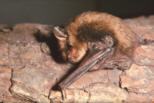 Brandt’s Bat. © R Stebbings Brandt’s Bat. © R Stebbings |
| Brown
Long-Eared - similar size to Daubenton’s. Feeds mainly in open
deciduous woodland and coniferous woodlands as well as parklands and orchards.
They may fly and ready themselves to feed in the roost for up to an hour before
emergence, which is usually late when it is fairly dark. This and the fact they
feed in woodland areas can make them difficult to spot. They will take insects
off the vegetation, gleaning, as well as catching them in free flight. They
often roost in barns, or other buildings with open roof voids. Long eared bats
echolocate quietly, so are hard to locate using a bat detector |
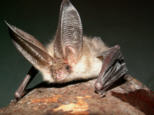 The Brown Long-Eared Bat ©
SLBG The Brown Long-Eared Bat ©
SLBG |
|
| Natterers
- This bat is uncommon in the South Lancashire area. It may be easily
confused with Daubentons as it is a similar size, and emerges after dark. This
bat feeds predominantly in open woodland, parklands, hedgerows and along
waterside vegetation. They have a fairly slow flight speed, sometimes over
water, with sharp turns. They are very manoeuvrable due to their wing shape,
which is specially adapted for feeding in woodland and flying between trees.
They usually fly fairly low to the ground (within 5 metres) but can be found
higher than this. Like the long eared these bats will also glean prey from the
foliage. |
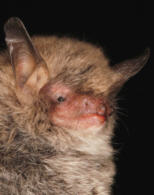 Natterer’s Bat.© BCT Natterer’s Bat.© BCT |
|
 45KHz
Pipistrelle. © Hugh Clarke
45KHz
Pipistrelle. © Hugh Clarke Soprano
Pipistrelle. © Hugh Clarke
Soprano
Pipistrelle. © Hugh Clarke Daubenton’s Bat. © J Kaczanow
Daubenton’s Bat. © J Kaczanow  Noctule Bat.
© R Stebbings
Noctule Bat.
© R Stebbings Whiskered
Bat. © BCT/P Richardson
Whiskered
Bat. © BCT/P Richardson Brandt’s Bat. © R Stebbings
Brandt’s Bat. © R Stebbings The Brown Long-Eared Bat ©
SLBG
The Brown Long-Eared Bat ©
SLBG Natterer’s Bat.© BCT
Natterer’s Bat.© BCT